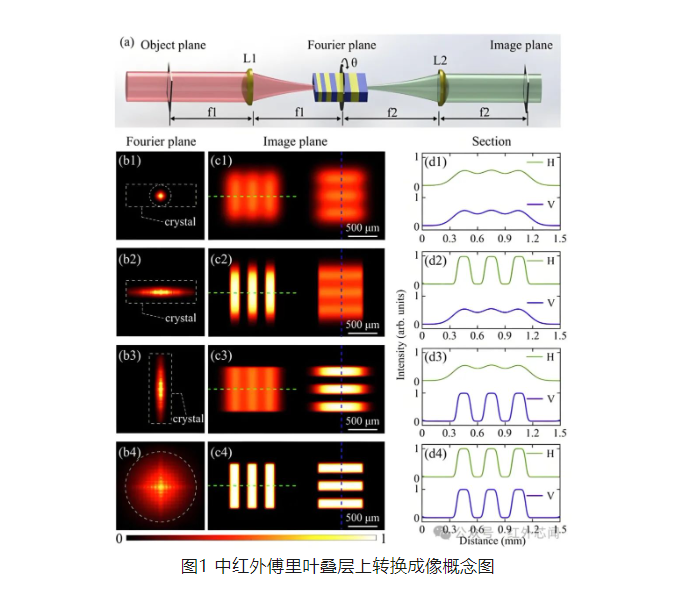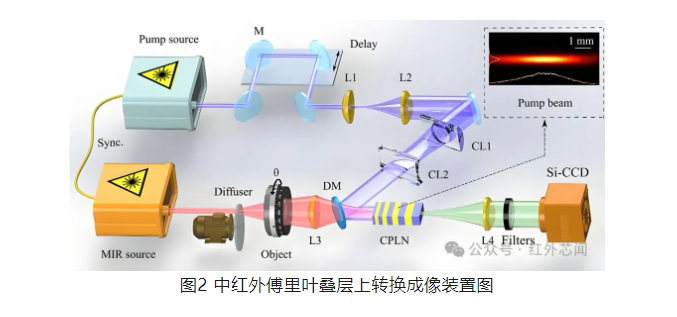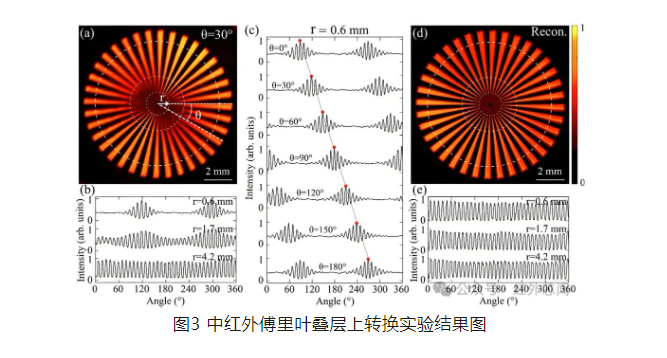26
2024
-
12
Mid-infrared nonlinear Fourier stacked imaging
Author:
Mid-infrared imaging can obtain unique information such as target radiation temperature and chemical composition, and has wide applications in fields such as biomedical science, materials science, and environmental monitoring. For a long time, developing mid-infrared imaging technology with a large field of view, high resolution, and high sensitivity has been an important goal pursued in the field of infrared measurement and control. This provides key support for meeting the application needs of extreme scenarios such as high throughput and low illumination, for example, long-distance infrared remote sensing, deep penetration imaging, low light toxicity biological tissue observation, and non-destructive detection of photosensitive materials. Currently, mid-infrared detection and imaging devices are limited by the narrow bandgap semiconductor materials used, which usually require low-temperature cooling to suppress severe dark current and background noise. Achieving high-sensitivity mid-infrared imaging at room temperature remains quite challenging. In this context, nonlinear upconversion detection technology has emerged, which converts infrared signals to the visible or near-infrared band with high fidelity through the optical parametric frequency conversion process, thus fully utilizing the mature and superior performance of photon detection and optical field manipulation devices in this band, providing an effective means for achieving room temperature mid-infrared single-photon measurement and control.
So far, upconversion detection technology has been successfully applied in many high-performance infrared imaging scenarios, demonstrating significant advantages in detection sensitivity and imaging frame rate. However, upconversion imaging systems are inevitably affected by spectral aperture limitations due to their reliance on nonlinear conversion, which significantly impacts spatial resolution in imaging. For a long time, it has been difficult to achieve imaging performance that combines a large field of view with high resolution. In particular, to improve the system's conversion efficiency, the upconversion process usually employs optical parametric wavelength conversion based on quasi-phase matching to avoid spatial walk-off between optical wave vectors and achieve a longer interaction distance. However, this technology requires specially designed nonlinear crystals that generate periodic domain inversion by applying a strong electric field (up to tens of thousands of volts per millimeter) inside the crystal to introduce periodic jumps in nonlinear polarization. Limited by current fabrication processes, the thickness of periodically poled crystals is usually on the order of millimeters while ensuring accuracy and consistency in polarization structure. The resulting crystal aperture greatly limits the working bandwidth of spatial spectra in 4f imaging systems. Therefore, to achieve higher spatial resolution, there is an urgent need to develop new nonlinear imaging architectures to break through the physical limitations of existing nonlinear media cross-sectional sizes and lay a foundation for advancing the broader application of infrared upconversion imaging technology.
According to reports from MEMS Consulting, recently, Professor Huang Kun from East China Normal University’s State Key Laboratory of Precision Spectroscopy Science and Technology and Professor Zeng Heping's team have made significant progress in high-resolution mid-infrared imaging. They proposed a new method for mid-infrared nonlinear Fourier ptychographic imaging that combines pump field spatial intensity control with spectral domain aperture synthesis algorithms. This breakthrough overcomes the long-standing bottleneck where traditional upconversion imaging system performance is limited by the cross-sectional size of nonlinear media, achieving large field of view, high resolution, and ultra-sensitive room temperature mid-infrared single-photon imaging. This provides a powerful means to meet the urgent demand for high-throughput infrared detection in fields such as materials science, chemical analysis, and biomedicine.The related research results were published inthe journal Optica.
The research team proposed a new method for mid-infrared nonlinear Fourier ptychographic imaging that utilizes optical field intensity control technology to elliptically shape and size control the pump light, thereby fully utilizing the lateral scale of nonlinear crystals; by rotating elliptical apertures in the Fourier spectral domain to obtain spatial high-frequency components of the object being measured in various directions; combined with Fourier ptychography algorithms for aperture synthesis expands the range of spatial spectra that can be converted by the imaging system, ultimately achieving high-resolution mid-infrared upconversion imaging that effectively breaks through aperture limitations introduced by traditional schemes involving nonlinear crystals. Figure 1 shows imaging performance under different pump conditions. In Gaussian pumping conditions, limited by crystal thickness, the beam diameter is small, making the aperture effect particularly significant and limiting the spatial resolution of the imaging system. In contrast, the width of the crystal cross-section is only limited by wafer size and can reach several centimeters, much larger than its thickness. Therefore, elliptical pumping can fully utilize the width dimension of the crystal to achieve significant resolution improvement along its long axis direction. Similarly, rotating elliptical apertures in Fourier space can achieve resolution enhancement in specific directions. By merging image information from two orthogonal directions effectively expands the collected spectral space to achieve overall enhancement in resolution along both horizontal and vertical directions.

Figure 2 shows a diagram of a mid-infrared upconversion imaging device based on Fourier ptychography. To obtain spatial spectral information from different directions of the target object, researchers precisely rotated samples using a rotation stage while collecting upconversion images at corresponding angles. This method is simpler and more convenient compared to rotating crystals (i.e., aperture diaphragms) and can achieve automatic optical alignment and data collection through electric-controlled displacement stages and rotation stages. Although collected images only contain intensity information, phase information of spectra can still be stably recovered within limited iterations using Fourier ptychography algorithms to merge multiple sets of spectral information and reconstruct high-definition images of samples. It is worth mentioning that chirped polarized nonlinear crystals were used in experiments; these have linearly chirped polarization periods along the direction of light transmission that can form gradient reciprocal lattice vectors to satisfy phase matching for wave vectors at different incident directions enabling large field-of-view and high-resolution upconversion imaging.

To better characterize the imaging performance of this technology, the research team used star-shaped test targets to study optical resolution in different directions. As shown in Figure 3, researchers rotated samples every 30°, collecting upconversion images at 12 angles equivalent to rotating an elliptical pump aperture around once. Images collected at a single angle have higher resolution in specific directions corresponding to the long axis orientation of elliptical apertures. In orthogonal directions relative to this orientation, image resolution is lower corresponding to short axis direction. At different rotation angles, directions with high-resolution image analysis change linearly following rotation. Combining intensity images collected multiple times with Fourier ptychography algorithms allows researchers to iterate and merge them effectively restoring isotropic high-resolution imaging effects. Under an imaging field-of-view diameter of 25 mm, a spatial resolution of 39 microns was achieved corresponding to a spatial bandwidth product (number of resolvable pixels) as high as 3.2×10⁵ which is at least an order of magnitude higher than previously reported records. Additionally, thanks to low noise conversion processes and highly sensitive silicon-based cameras, researchers also demonstrated ultra-sensitive imaging performance at single-photon levels with incident infrared light intensity as low as 1 photon/pulse/pixel achieving large field-of-view high-resolution ultra-sensitive mid-infrared single-photon imaging performance.

The nonlinear Fourier stacking imaging technology has achieved effective aperture sizes that are difficult to reach with existing nonlinear media, breaking through the long-standing dilemma of achieving both a large field of view and high resolution in mid-infrared upconversion imaging systems. In the future, this technology can be extended to other wavelengths lacking efficient imaging methods, and by selecting suitable nonlinear media, it is expected to achieve high-sensitivity detection and high-resolution imaging in the long-wave infrared or terahertz spectrum, providing support for non-invasive, non-destructive high-precision material analysis and characterization. Additionally, by combining advanced spectral imaging technology with computational imaging algorithms, it is expected to develop a spatial-spectral-temporal high-resolution multidimensional mid-infrared imaging framework, providing new means for obtaining high-throughput infrared information in fields such as biology, materials, and chemistry.
Recently, Researcher Huang Kun and Professor Zeng Heping's team have made a series of breakthrough advancements in mid-infrared nonlinear measurement and control, constructing a low-threshold mid-infrared fiber parametric oscillator [Photon. Res. 12, 2123 (2024)], achieving ultra-sensitive mid-infrared single-photon detection [Adv. Photon. Nexus 3, 046002 (2024), Photonics Res. 12, 1294 (2024)], developing wide-band mid-infrared single-pixel spectral technology [Laser Photon. Rev. 18, 2301272 (2024), Laser Photon. Rev. 18, 2401099 (2024)], and demonstrating high frame rate mid-infrared hyperspectral imaging [Nat. Comm. 15, 1811 (2024)].
Chongqing Chongfan Technology Co., Ltd. Optical platform Film thickness gauge OCT Optical coherence tomography LabVIEW control
LATEST NEWS
2025-01-09
Design and Development of Full-Spectrum Photodetectors
In recent years, the booming optoelectronic industry has changed the world and extended into many aspects of life. Among them, photodetectors (PDs) with a wide response bandwidth from deep ultraviolet to visible to near-infrared serve as important optoelectronic components and play a key role in daily life.
2025-01-08
Black arsenene multi-spectral integrated field-effect transistors, aiding high-resolution imaging and enhanced secure communication.
With the development of modern communication technology, the demand for broadband, room-temperature infrared, and terahertz (THz) detectors has rapidly increased. These detectors play a crucial role in fields such as telecommunications, security inspection, non-destructive testing, and medical diagnostics. However, existing optical detectors face challenges such as high intrinsic dark current and the need for low-temperature cooling, which limit their efficiency in detecting low-energy photons. Particularly in the terahertz band, the photon energy is insufficient to excite electron transitions from the valence band maximum (VBM) to the conduction band minimum (CBM), making effective optoelectronic conversion difficult. Therefore, researchers have been seeking ultra-broadband detectors that can operate at room temperature and respond to wavelengths ranging from visible light to the terahertz band.
2024-12-30
Laser-based tiered neurons achieve high-speed reservoir computing.
Neuromorphic computing is a computational paradigm that simulates the functions and architecture of biological neurons. A single biological neuron is a powerful computational unit with information processing capabilities, information transmission abilities, and memory functions. Therefore, it is crucial to design a photonic neuromorphic processor that can truly emulate the powerful computational functions of biological neurons.
2025-01-01
Design and Development of Full-Spectrum Photodetectors
In recent years, the rapidly growing optoelectronic industry has changed the world and extended into many aspects of life. Among them, photodetectors (PDs) with a wide spectral response from deep ultraviolet to visible to near-infrared serve as important optoelectronic components and play a key role in daily life.
2024-12-31
High-sensitivity quantum dot photodetectors from deep ultraviolet to near-infrared
In recent years, the rapidly growing optoelectronic industry has changed the world and extended into many aspects of life. Among them, photodetectors (PD) with deep ultraviolet-visible-near infrared full spectrum detection response serve as important optoelectronic components, playing a key role in daily life.

